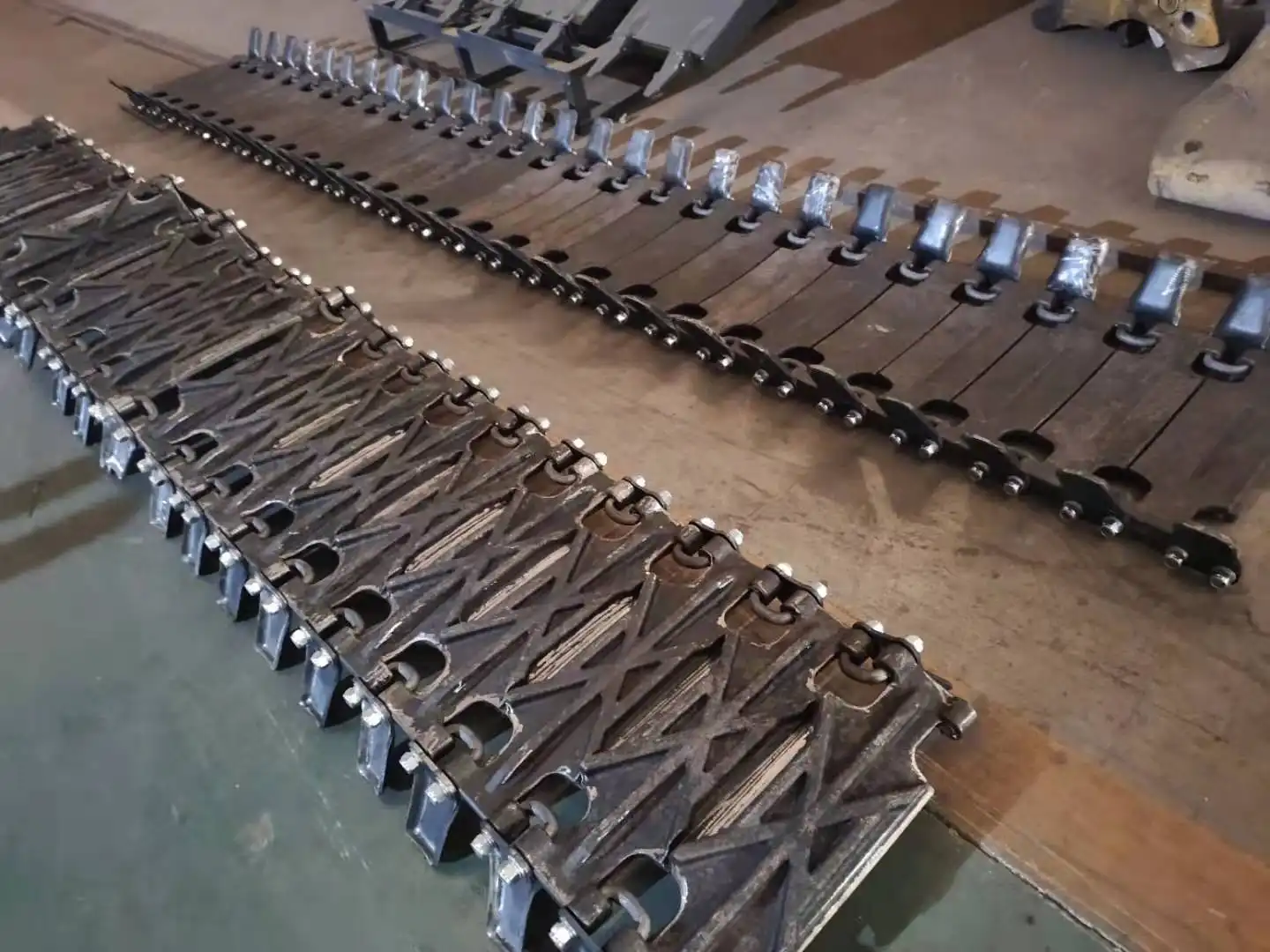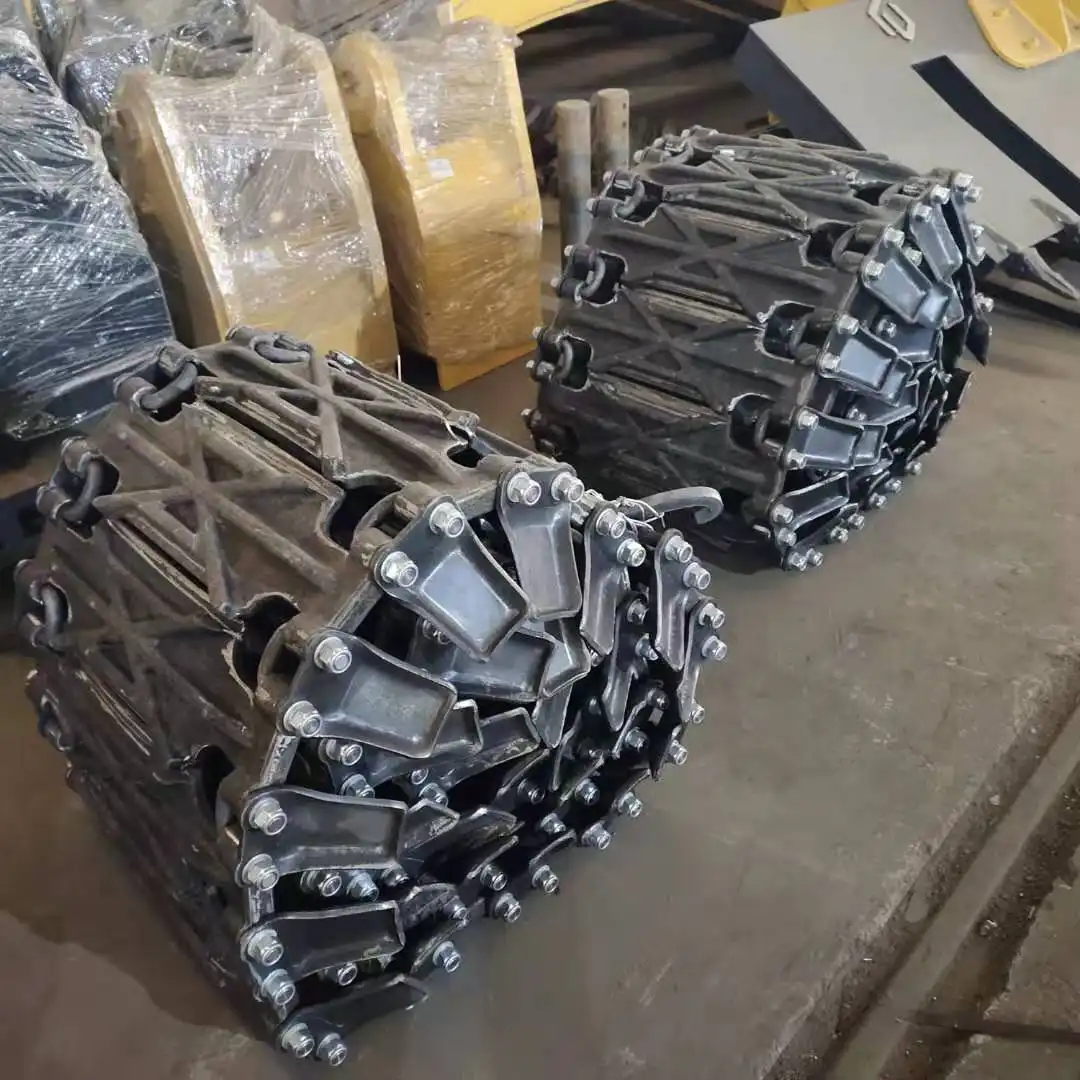What is a Tyre Protection Chain?
A tyre protection chain represents one of the most crucial investments for heavy equipment operators working in demanding environments. These specialized protective systems consist of interlocking steel mesh networks designed to shield expensive tires from damage caused by sharp debris, abrasive surfaces, and extreme operating conditions. The loader tire protection chain serves as a defensive barrier that wraps around the tire, creating a resilient shield that absorbs impact and prevents punctures while maintaining optimal traction. Unlike traditional tire chains used for snow traction, protection chains focus primarily on extending tire life and reducing operational costs in harsh industrial settings. They're engineered with flexible steel alloys that conform to tire deformation during operation, ensuring consistent protection without compromising performance. For construction companies, mining operations, and demolition contractors, these chains transform tire maintenance from a constant expense into a manageable investment, often tripling tire lifespan while reducing downtime and replacement costs significantly.
Key Functions and Benefits
Understanding the multifaceted advantages of tire protection systems reveals why they've become indispensable for modern heavy equipment operations. These protective solutions deliver value across multiple operational dimensions.
Tire Longevity Enhancement
The primary function of protection chains centers on dramatically extending tire service life through comprehensive damage prevention. Sharp rocks, metal debris, and abrasive surfaces that would normally cause sidewall cuts, tread punctures, and premature wear become manageable challenges when chains absorb and distribute impact forces. Operators frequently report tire life extensions of 200-300%, transforming what was once a monthly expense into an annual consideration. This longevity improvement stems from the chain's ability to create a sacrificial layer that takes the beating while preserving the underlying rubber structure.
Enhanced Traction and Stability
Beyond protection, these chains significantly improve equipment traction on challenging surfaces. The interlocking mesh design creates additional grip points that help loaders maintain stability on loose gravel, muddy terrain, and slippery surfaces. This enhanced traction translates directly into improved productivity, as operators can work more aggressively without fear of tire damage or loss of control. The confidence boost alone often justifies the investment, as operators push equipment harder knowing their tires remain protected.
Operational Cost Reduction
The financial benefits extend far beyond simple tire replacement savings. Reduced tire changes mean less equipment downtime, lower labor costs for maintenance crews, and decreased inventory requirements for spare tires. Many operations discover that protection chains pay for themselves within the first few months through reduced tire purchasing alone. Additionally, the improved fuel efficiency that comes from better traction and reduced tire slippage contributes to ongoing operational savings that accumulate over time.

Structural Components and Materials
The engineering behind effective tire protection demands sophisticated material science and precise manufacturing to withstand the extreme conditions these chains encounter daily.
Advanced Alloy Construction
Modern loader tire protection chains utilize specialized steel alloys incorporating chrome, manganese, and molybdenum to achieve the optimal balance of hardness and flexibility. These alloys are manufactured from a special mesh of high wear-resistant but flexible Chrome, Manganese, and Molybdenum alloy steel links that can withstand repeated impact while maintaining structural integrity. The metallurgical composition requires precise heat treatment to achieve the necessary hardness ratings while preserving enough ductility to prevent brittle failure under stress. This careful material engineering ensures chains remain effective throughout extended service periods without premature link failure or excessive stretching.
Mesh Design and Link Configuration
The protective mesh configuration plays a critical role in chain effectiveness and durability. Link size, spacing, and interconnection patterns must balance protection coverage with flexibility to accommodate tire deformation during operation. Smaller mesh patterns provide superior puncture resistance but may trap debris, while larger patterns offer better self-cleaning properties at the expense of some protection. Leading manufacturers have developed proprietary link geometries that optimize this balance, creating chains that protect comprehensively while maintaining excellent debris-shedding characteristics.
Attachment and Tensioning Systems
Proper loader tire protection chain installation and retention depend on sophisticated mounting hardware designed to maintain optimal tension throughout the operating cycle. Modern systems incorporate quick-release mechanisms that allow rapid installation and removal while ensuring secure attachment during operation. Tensioning devices automatically adjust for tire pressure variations and thermal expansion, preventing chain loosening that could lead to damage or loss. These systems represent significant engineering achievements, transforming what was once a complex installation process into a straightforward maintenance procedure.
Applications
The versatility of tire protection chains makes them valuable across numerous industries where heavy equipment operates in challenging conditions that threaten tire integrity.
Mining and Quarrying Operations
Mining environments present perhaps the most demanding conditions for loader tire protection chains. Sharp rock fragments, metal debris, and extreme temperatures create a perfect storm of tire-destroying conditions. They protect loader tyres from sharp rocks, hot slag, scrap metal, and abrasive surfaces. They are commonly used in mining, quarries, recycling, and steel plants. Large-scale mining equipment, including massive wheel loaders and haul trucks, relies on protection chains to maintain operational efficiency in these harsh environments. The investment in protection chains becomes particularly critical when considering the cost of replacement tires for large mining equipment, which can exceed tens of thousands of dollars per tire.
Construction and Demolition Sites
Construction sites present unique challenges with mixed debris fields containing everything from concrete fragments to steel reinforcement. Demolition operations amplify these risks with unpredictable debris patterns and constantly changing surface conditions. The loader tire protection chain systems used in these applications must handle not only sharp objects but also the thermal cycling that occurs when equipment moves between different surface types and temperatures throughout the workday. The ability to maintain productivity while protecting against unexpected punctures makes these chains essential for construction fleet management.
Waste Management and Recycling
Waste processing facilities and recycling operations create particularly hostile environments for tires due to the unpredictable nature of processed materials. Sharp metal fragments, glass shards, and chemical exposure combine to create extreme tire wear conditions. Protection chains in these applications often incorporate additional chemical resistance treatments to handle exposure to various waste streams. The self-cleaning properties of quality chain designs become especially important in these environments where accumulated debris could compromise equipment operation or create safety hazards.

FAQ
①How long does installation take?
Professional installation typically requires two people approximately one hour per set, though experienced crews can reduce this time significantly with practice.
②Do protection chains affect equipment speed?
Modern chains are designed to maintain normal operating speeds while actually improving traction and stability in challenging conditions.
③What maintenance do chains require?
Quality chains require minimal maintenance beyond periodic inspection for wear and proper tensioning adjustment.
④Can chains be repaired if damaged?
Individual links can often be replaced, though extensive damage typically requires complete chain replacement.
⑤How do I know when chains need replacement?
Visual inspection for excessive wear, link stretching, or broken connections indicates replacement time.
Tire protection chains represent a strategic investment that transforms equipment operating economics while improving safety and productivity. The combination of extended tire life, enhanced traction, and reduced downtime creates compelling value propositions for operations facing challenging surface conditions. As equipment continues growing larger and more expensive, the importance of protecting these substantial investments becomes increasingly critical. Loader tire protection chain systems from quality manufacturers deliver proven performance that justifies their adoption across diverse industrial applications.
At Tiannuo, we take pride in offering advanced protection chain solutions that deliver exceptional value through superior engineering and proven performance. Our systems are meticulously designed to safeguard tires and significantly extend their lifespan by a remarkable factor of three. By choosing our product, you can bid farewell to frequent tire replacements and the associated costs.
One of the standout features of our systems is their quick installation process. Unlike conventional solutions that may require extensive manpower and time, our systems can be easily installed by just two people within a mere hour. This not only saves you valuable time but also minimizes operational disruptions, allowing your business to continue running smoothly with minimal downtime.
Our protection systems are engineered for reliability. They maintain impressively low failure rates, ensuring consistent performance throughout their operational life. Furthermore, they are designed to require minimal maintenance, reducing the need for frequent inspections, repairs, and upkeep. This translates to lower overall maintenance costs and less time spent on servicing the systems, enabling you to focus more on your core business operations.
In terms of performance enhancement, our systems go above and beyond. They provide superior traction, giving your vehicles or machinery a better grip on various surfaces. This improved traction is particularly beneficial in challenging conditions, where it can significantly enhance safety and operational efficiency. By boosting operational efficiency, our systems help you achieve more in less time, thereby increasing your productivity and profitability.
Moreover, our advanced protection solutions contribute to reduced fuel consumption. By optimizing the performance of your tires and reducing rolling resistance, you help your vehicles or machinery operate more efficiently. This leads to substantial fuel savings over time, which can have a significant positive impact on your operational budget. The time savings achieved through quick installation and minimal maintenance further add to the comprehensive benefits of our systems, making them a worthwhile investment for any operation looking to optimize its resources and reduce costs.
If you are interested in learning more about our complete range of tire protection solutions and how they can be tailored to meet the specific needs of your operation, we invite you to contact our experienced technical specialists. You can reach them at rich@stnd-machinery.com. They are well-equipped to provide you with detailed information, answer any questions you may have, and assist you in selecting the most suitable solutions for your unique requirements. Choose Tiannuo's advanced protection systems and experience the difference that quality, reliability, and innovation can make for your business.
References
- Johnson, M.R., "Heavy Equipment Tire Protection Systems: Engineering Analysis and Performance Evaluation," Industrial Equipment Quarterly, Vol. 45, No. 3, 2023.
- Chen, L.K., "Metallurgical Advances in Tire Chain Alloy Development," Materials Science in Mining Applications, 2024.
- Rodriguez, A.P., "Cost-Benefit Analysis of Tire Protection Systems in Mining Operations," Mining Equipment Management Review, 2023.
- Williams, D.T., "Installation and Maintenance Best Practices for Heavy Equipment Tire Chains," Construction Equipment Maintenance Handbook, 2024.
- Thompson, S.J., "Environmental Impact and Efficiency Improvements from Tire Protection Chain Implementation," Sustainable Construction Practices Journal, 2023.
About Author: Arm
Arm is a leading expert in the field of specialized construction and railway maintenance equipment, working at Tiannuo Company.

